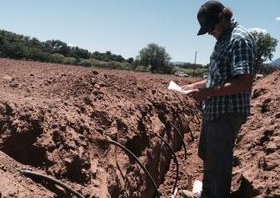For one Idaho Grower, the ultimate in water use efficiency on his farm boils down to two words: drip irrigation.
McKellip, who lives and works in the Treasure Valley north of Nampa, Idaho, installed his first drip irrigation — a Toro system — on one of RMF Farms’ fields in 2011. He installed a second system the following year; then, in 2013, a third. That 2013 field was seeded into sugarbeets. Prior to those drip systems, all his fields were grown under furrow irrigation.
A drip-irrigated field of mint in 2012 yielded 133 pounds of mint per acre, compared to a nearby furrow-irrigated mint field that came off at 94 pounds. The bottom line was $585 more income per acre, along with significant savings in water and fertilizer use, combined with less labor, fuel, equipment usage and insecticide inputs.
Continue reading











